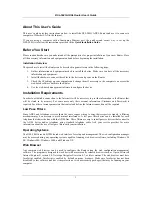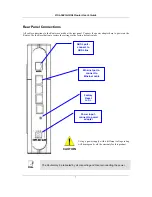
DSL-504G ADSL Router User’s Guide
2
Ethernet Port (NIC Adapter)
Any computer that uses the Router must be able to connect to it through the Ethernet port on the Router. This
connection is an Ethernet connection and therefore requires that your computer be equipped with an Ethernet
port as well. Most notebook computers are now sold with an Ethernet port already installed. Likewise, most fully
assembled desktop computers come with an Ethernet NIC adapter as standard equipment. If your computer does
not have an Ethernet port, you must install an Ethernet NIC adapter before you can use the Router. If you must
install an adapter, follow the installation instructions that come with the Ethernet NIC adapter.
Additional Software
It may be necessary to install software on your computer that enables the computer to access the Internet.
Additional software must be installed if you are using the device a simple bridge. For a bridged connection, the
information needed to make and maintain the Internet connection is stored on another computer or gateway
device, not in the Router itself.
If your ADSL service is delivered through a PPPoE or PPPoA connection, the information needed to establish
and maintain the Internet connection can be stored in the Router. In this case, it is not necessary to install
software on your computer. It may however be necessary to change some settings in the device, including
account information used to identify and verify the connection.
All connections to the Internet require a unique global IP address. For bridged connections, the global IP settings
must reside in a TCP/IP enabled device on the LAN side of the bridge, such as a PC, a server, a gateway device
such as a router or similar firewall hardware. The IP address can be assigned in a number of ways. Your network
service provider will give you instructions about any additional connection software or NIC configuration that
may be required.
Record Your Account Information
Information you will need from your ADSL service provider:
Username
This is the Username used to log on to your ADSL service
provider’s network. It is commonly in the form
−
[email protected]. Your ADSL service provider uses this to
identify your account.
Record info here
Password
This is the Password used, in conjunction with the Username
above, to log on to your ADSL service provider’s network.
This is used to verify the identity of your account.
Connection Type
This is the method your ADSL service provider uses to send
and receive data between the Internet and your computer.
Your Router supports the following connection protocols:
PPPoE LLC, PPPoE VC-Mux, PPPoA LLC, 1483 Routed IP
VC-Mux, 1483 Routed IP LLC, 1483 Routed IP (1577), 1483
Bridged IP VC-Mux and 1483 Bridged IP LLC.
Security Protocol
This is the method your ADSL service provider will use to
verify your Username and Password when you log on to their
network. Your Router supports the PAP and CHAP protocols.
VPI
This is the Virtual Path Identifier (VPI). It is used in
conjunction with the Virtual Channel Identifier (VCI) below, to
identify the data path between your ADSL service provider’s
network and your computer.
VCI
This is the Virtual Channel Identifier (VCI). It is used in
conjunction with the VPI above to identify the data path
between your ADSL service provider’s network and your
computer.
Summary of Contents for DSL-504G
Page 1: ...DSL 504G ADSL Router User s Guide April 2004 ...
Page 8: ......
Page 68: ......
Page 71: ......











































